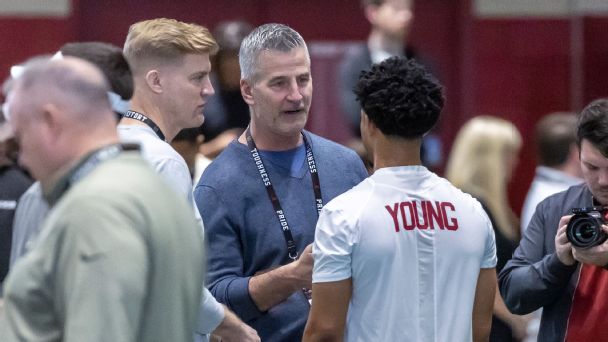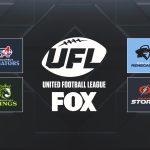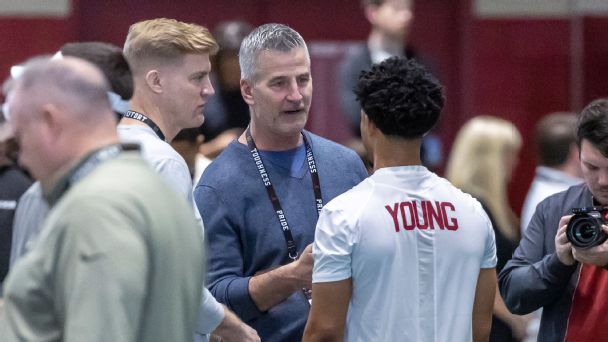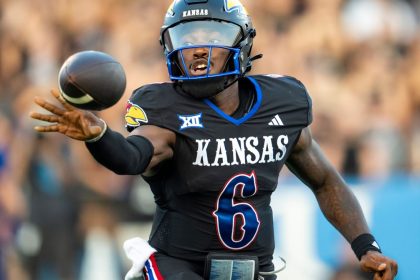
CHARLOTTE, N.C. — Scott Fitterer appeared relaxed, as relaxed as a general manager with the No. 1 overall pick of the NFL draft could be nine days away from making the biggest decision of his professional career.
Even though he hadn’t asked new Carolina Panthers coach Frank Reich which quarterback he favored between Alabama’s Bryce Young and Ohio State’s C.J. Stroud prior to his final pre-draft news conference last week, he was confident they would be on the same page when he popped the question.
League sources familiar with the team’s plans, oddsmakers and many draft analysts believe the Panthers’ choice at No. 1 in Thursday’s NFL draft (8 p.m. ET on ESPN, ABC, ESPN App) will be Young despite his 5-foot-10, 204-pound frame that has skeptics concerned about his durability.
All Fitterer allowed was that the Panthers have clarity this time with the No. 1 overall pick.
“We do see things the same way,’’ he said of himself and Reich, a former NFL quarterback for 13 years. “We value the same traits, the same characteristics. There’s certain things we really want, and that’s where the clarity comes from.’’
There wasn’t clarity at this point in 2011, the last time Carolina had the top pick. The staff was divided on whether to take Auburn quarterback Cam Newton to the point the situation had become volatile during a meeting less than 48 hours before the draft, according to a person who was in the room that day.
There were questions about Newton’s decision-making and his unique style as a dual-threat quarterback. There were questions about his character going back to his freshman year at Florida, when he stole a laptop, and later when he was accused of having a pay-for-play plan to go to Mississippi State.
Then-first year coach Ron Rivera angrily told everyone in the room he was tired of hearing what Newton couldn’t do for the organization and demanded they focus on what Newton could do.
Two days later, the Panthers made Newton the No. 1 overall pick. Five years later, Newton was the league MVP, leading Carolina to Super Bowl 50.
The absence of issues surrounding the character of Young and Stroud is one reason Fitterer was so relaxed.
“Guys have done a ton of work and we’re prepared,’’ Fitterer said.
Another is believing in the process that led him to send four draft picks and top wide receiver DJ Moore to the Chicago Bears to move up from ninth to first for a shot at Young or Stroud.
Bill Polian, the first general manager of the Panthers in 1995, understands. He went through the process of looking for a quarterback with the top pick in 1995, when he traded down to No. 5 to select Kerry Collins, and in 1998 with the Indianapolis Colts, when he stayed at No. 1 and chose Peyton Manning.
He said the process of getting to know the players as people, a process that is much more intense now than it was the last time he had the top pick, was more important than evaluating them on the field.
“By a factor of 10,’’ Polian said.
The process for Fitterer began in the fall when he and assistant general manager Dan Morgan began attending games played by Young, Stroud, Kentucky’s Will Levis and Florida’s Anthony Richardson — the four quarterbacks they felt could be a long-term solution to their long-term problem.
The next step, after Carolina completed its fifth straight losing season with the No. 9 pick and hired Reich, was to get the No. 1 pick. Fitterer pulled that off on March 10, believing, according to NFL front office sources, that was the only way he would have a shot at Young or Stroud.
“I feel through this process we made the right decision,’’ Fitterer said. “… I’d hate to be at [No. 9] right now trying to figure this out.’’
The Panthers kept Richardson and Levis in the conversation throughout the process even though Young and Stroud were the primary targets from the day the trade was made, according to a league front office source familiar with the situation.
As intriguing as Richardson was at 6-4 and 244 pounds, having only 13 college starts and a low 2022 completion percentage (53.8%) made him too much of a project to take at No. 1, the source said.
Fitterer never budged from saying all four were a factor throughout.
“We are consciously trying to keep all four in there so we can ask every question and look at it from every angle to make sure we’re making the right decision,’’ Fitterer said. “We want to keep this process open all the way through.’’
It wasn’t nearly that open in 2011 because there was such a large drop-off in quarterback talent after Newton. That’s why Rivera desperately sought clarity so close to draft night.
In 1995, it was a two-quarterback race when Carolina’s options were Collins and Alcorn State’s Steve McNair, who went No. 3 to the Houston Oilers.
“Sometimes it’s close, like with Kerry and Steve,’’ Polian recalled, noting that the vetting process made Manning the easy pick over Ryan Leaf for Indianapolis in 1998. “But that time of getting to know them was important.’’
The process this year intensified for Carolina on March 23 when Ohio State held its pro day, followed by Alabama’s the next day.
The Panthers sent an army of about a dozen team officials, including owners David and Nicole Tepper, to both. But it wasn’t so much what they learned on the field as it was what they learned about the prospects at dinner the night before.
Football was barely a part of the conversation.
“For us, that’s the biggest thing going through this process, getting to know these guys, digging down deep into who they are as people,’’ Morgan said.
This part of the process affirmed all the research Panthers director of college scouting Cole Spencer and his team had done throughout the process, which began as soon as the prospects became college starters.
“We’ve seen these guys multiple times throughout these past two years, whether it’s practice exposure, going to the school, talking to the staffs at the school, strength [coaches], trainers, and then seeing the live game exposure,’’ he said.
As intense as the vetting process was, it didn’t reach the level it did with Newton in 2011 when scout Khari Darlington’s job from mid-January through the draft was to shadow Newton.
But it wasn’t until Rivera and general manager Marty Hurney went separately to Atlanta the week before the 2011 draft that they had the clarity needed to draft him.
“By the time they came back, I felt like they had their mind all the way made up this was the direction we were going to go,’’ Darlington said.
Fitterer and Reich needed no last-minute trips this year.
With all of the preparation the Panthers have done, it’s no wonder Fitterer appeared so relaxed that close to making the top overall pick this Thursday.
“So I know we made the right decision to go up there,’’ Fitterer said. “When we made the [trade], we felt strongly there would be a guy there that we wanted.
“The next step is going to be execution on draft day.’’










